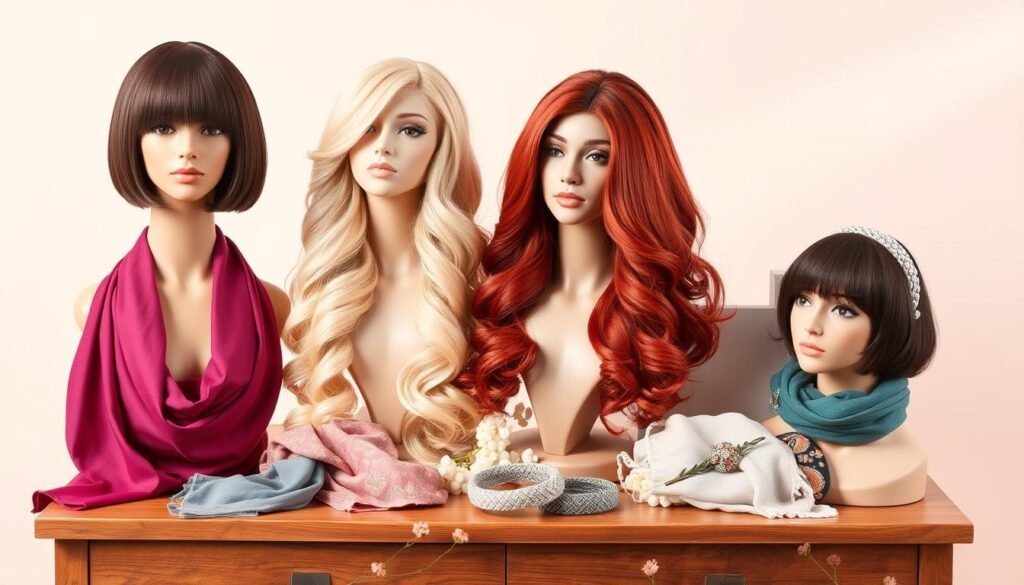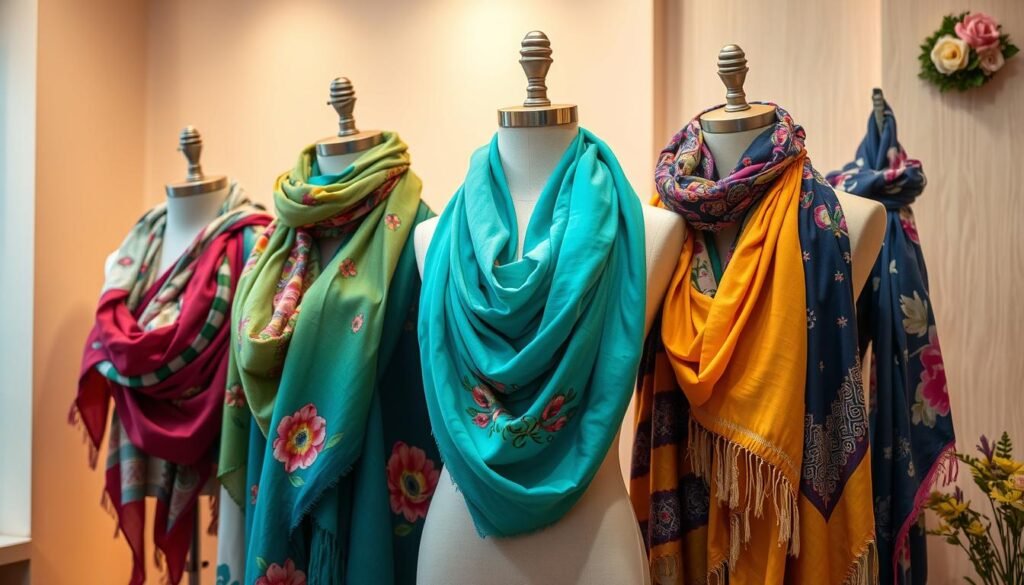Did you know about 6.8 million people in the United States have alopecia? This condition causes hair loss. Many people feel alone and anxious because of it. Finding practical solutions is crucial. This article looks at everyday solutions for alopecia, like using wigs and scarves. These tools can help improve comfort and confidence. We will talk about how to manage hair loss and cope with the emotional and social challenges it brings.
Key Takeaways
- Understanding alopecia’s emotional and psychological impact is vital for effective coping strategies.
- Wigs and scarves can provide stylish and practical solutions for daily life.
- Implementing scalp care routines can improve overall scalp health, enhancing comfort.
- Joining support networks and communities can foster emotional well-being.
- Confidence-building techniques, such as personal style, can empower individuals living with alopecia.
Understanding Alopecia and Its Impact
Alopecia represents a complex condition that causes hair loss. It affects people differently. We will look into alopecia, its types, and how it affects emotions.
What is Alopecia?
Alopecia is an autoimmune disorder. It makes the immune system attack hair follicles, leading to hair loss. Anyone can get it, no matter their age or gender. Sometimes hair loss is temporary, but it can also be chronic. Understanding alopecia helps us support those affected.
Types of Alopecia
There are several types of alopecia, each with its own traits:
| Type of Alopecia | Description | Commonality |
|---|---|---|
| Alopecia Areata | Patchy hair loss, often sudden and localized. | Common |
| Alopecia Totalis | Total hair loss on the scalp. | Less common |
| Alopecia Universalis | Complete hair loss on the entire body. | Rare |
Emotional and Psychological Effects
The emotional effects of hair loss are deep. They affect self-esteem and mental health. Many feel insecure or anxious about how they look.
The stress from hair loss can cause isolation, depression, and a loss of identity. It’s important to talk about these emotional effects. We should support people who are going through this.
Practical Solutions for Everyday Life with Alopecia
People with alopecia can find daily life easier with some practical changes. Small changes in daily habits can make managing hair loss easier. It also helps boost confidence. Having a supportive routine helps maintain a positive mindset.
Integrating Alopecia into Daily Routines
Having a streamlined routine makes living with alopecia smoother. Morning routines can include:
- Choosing a makeup routine that highlights natural beauty quickly.
- Picking comfortable headwear like beanies or scarves that show your style.
- Adding self-care to focus on skincare and feeling good about oneself.
At night, activities like reading or gentle yoga can help relax. They allow your mind to rest after a long day.
Managing Expectations and Lifestyle Adjustments
Keeping expectations realistic is important for emotional health. Making changes in lifestyle can help in coping better.
- Being flexible with social plans can lessen worry about how you look.
- Accepting yourself gradually instead of seeking perfection reduces anxiety about losing hair.
- Building a network of friends or groups who understand alopecia can provide a sense of belonging and support.

Wig Recommendations for Different Styles
People dealing with alopecia find relief in choosing the right wig. It boosts their confidence and makes them comfortable. When choosing wigs, think about what fits your style, life, and budget. We’ve put together tips to help you pick a wig that matches your taste.
Choosing the Right Wig for Your Needs
Finding the right wig means looking at a few key things. Consider your type of hair loss and the look you want. Also, think about how often you’ll wear it. You can pick from synthetic wigs for a friendly price or human hair wigs for natural feel. Check out this guide for help in choosing a wig that fits your life.
Wig Care and Maintenance Tips
Good wig care is important to make them last. Clean and store your wigs the right way to keep them nice. Here’s what to do:
- Choose gentle shampoo and conditioner for wigs.
- Wash them softly and don’t scrub hard.
- Keep them on a stand to hold their shape.
- Avoid using hot tools unless your wig can handle heat.
With a regular care routine, your wigs will stay looking fresh and real.
Affordable vs. High-End Options
There are many kinds of wigs, from affordable wigs to luxury ones. For those watching their spending, synthetic wigs offer style on a budget. High-end human hair wigs give a real look and flexibility in styling. Think about the benefits and drawbacks of each before you buy. For more tips on wig choices and styling, go to Ageless Glimmer.

Exploring the Use of Scarves
Scarves are a multipurpose accessory that helps people with alopecia. They change how outfits look and add comfort plus style. They offer a way to express oneself creatively, making them perfect for enhancing one’s look.
Style Tips for Scarves
For those looking into styling scarves, there are many ways to wear them. Here are some ideas:
- Classic Wrap: Fold the scarf into a triangle. Wrap it around your head and tie it at the back for a timeless style.
- Turban Style: Twist the scarf and wrap around your head for an elegant look.
- Side Knot: Use a longer scarf to make a side knot for a playful look.
- Bow Accent: Tie the scarf with a bow on top for a fun, feminine feel.
Accessorizing with Scarves
Scarves can beautifully accessorize outfits for those with alopecia. Mixing scarves with different accessories adds to your style. Try combining scarves with:
- Bold Earrings: Statement earrings can draw the eye and enhance your look.
- Hats: A stylish hat looks great with a scarf and adds warmth or protection.
- Layered Necklaces: Wearing multiple necklaces under a scarf creates a chic, layered style.

Scalp Care Routines for Alopecia
For people with alopecia, keeping the scalp healthy is key. A good scalp care routine can make you feel better and may help hair grow back. Using the right products and home remedies helps get a healthier scalp.
Essential Scalp Care Products
Choosing products for alopecia means picking those for sensitive skin. Gentle cleansers, moisturizers, and healing oils can change your scalp care for the better. Here are kinds of products to look for:
- Gentle Cleansers: Pick shampoos without sulfates to avoid scalp irritation.
- Moisturizers: Creams or oils keep the scalp from drying out and soothe irritation.
- Healing Oils: Tea tree oil or jojoba oil can reduce inflammation.
Homemade Remedies for Scalp Health
Homemade remedies are a great gentle choice for scalp health. They’re effective and loved by many who lose hair. Try these:
- Coconut Oil Treatment: Warm coconut oil on the scalp for an hour before washing nourishes deeply.
- Aloe Vera Gel: Putting fresh aloe vera gel on the scalp hydrates and heals.
- Apple Cider Vinegar Rinse: Mixing apple cider vinegar with water as a post-shampoo rinse can improve scalp health and balance pH.
Creating a personal scalp care routine with the right alopecia products and home remedies can improve scalp health. Taking action helps people with alopecia feel better and more supported on their hair care journey.
Coping Strategies for Hair Loss Management
Dealing with hair loss can be tough. Effective coping strategies are key for those going through it. Connecting with others in the same situation can really help.
A strong support network is essential for anyone facing alopecia. It brings understanding and shared stories, making the journey less lonely.
Building a Support Network
Having friends, family, and support groups around makes a big difference. Sharing stories and challenges with them can bring comfort. It helps reduce feelings of being alone and offers a safe place to talk about hair loss.
Finding Emotional Support
Seeking professional help, like therapy, can be very helpful. It provides support and helps grow coping skills during hard times. Taking this step can improve how you handle emotions and boost self-esteem. For more tips on handling hair loss, check out this resource.
Confidence-Building Techniques
Boosting confidence is vital for those dealing with alopecia. Techniques exist to boost self-assurance and improve social skills. It’s important to focus on skills like public speaking and personal style. These skills help create a positive self-image, which is crucial when coping with hair loss.
Public Speaking and Presentations
Public speaking can be scary, especially with alopecia. People often worry about being judged. But, gaining confidence here is about practice and preparation. Let’s look at some strategies:
- Know Your Material: Being well-prepared makes you less anxious and more confident.
- Practice Regularly: Practice your speech in familiar places to feel at ease.
- Engage with the Audience: Connecting with listeners makes speaking fun and less scary.
- Visualize Success: Picture a great presentation to boost your mindset.
These techniques can make public speaking empowering. For more tips, check this resource.
Finding Comfort in Personal Style
Personal style is key for confidence. Choosing outfits that reflect you can feel empowering. Here are some tips:
- Wear What You Love: Select clothes that match your taste and make you feel true to yourself.
- Accessorize Thoughtfully: Use scarves, earrings, or hats to show your style and feel comfortable.
- Experiment with Colors: Bright and bold colors can lift your spirits and show confidence.
Personal style boosts confidence greatly. It’s about expressing yourself and feeling good in your skin, especially when facing alopecia.
| Technique | Description | Benefits |
|---|---|---|
| Practice Regularly | Rehearsing your presentation to gain familiarity and comfort. | Increases confidence and reduces anxiety during public speaking. |
| Engage with the Audience | Interacting with attendees to create a connection. | Makes speaking more enjoyable and less intimidating. |
| Wear What You Love | Dressing in outfits that express personal style. | Promotes self-assurance and comfort in appearance. |
Using these strategies helps manage alopecia’s emotional side. By developing confidence-building habits, people can embrace their uniqueness and style more freely.
Engaging with the Alopecia Community
People dealing with alopecia find great support in the alopecia community. It helps them feel they belong and offers ways to cope with hair loss. Connecting with those who understand makes a big difference.
Finding Online Support Groups
There are online groups that help people with alopecia. Members can share stories, get advice, and feel less alone. You can find groups on:
- Facebook groups dedicated to alopecia support
- Reddit forums, including r/alopecia
- Dedicated websites that focus on alopecia awareness and support
Joining these groups let you swap tips and stories. They bring people together from all over, creating a strong community.
Participating in Local Meetups
Meeting in person adds a special touch. These gatherings are a chance to share stories and support directly. You can find events like:
| Event | Location | Frequency |
|---|---|---|
| Alopecia Awareness Walks | Various parks and community centers | Annually |
| Support Group Meetings | Local community centers | Monthly |
| Conference Events | Major cities across the U.S. | Annually |
These meetups are great for making friends who get it. They reinforce community ties and open paths to new friendships.
Joining the alopecia community online and in person helps people grow stronger. For tips on living with alopecia, check out this article.
Conclusion
Living with alopecia has its challenges, yet it offers practical solutions for daily life. Learning about its emotional effects is key. Using strategies like embracing wigs and scarves adds flair and boosts confidence. This makes handling alopecia more manageable.
Accepting oneself is crucial on this journey. Connecting with others through online forums or local groups offers comfort. These connections build resilience, helping deal with hair loss challenges.
Embracing your alopecia journey can truly empower you. This article aims to support and remind you that you’re not alone. By finding helpful solutions and community support, dealing with alopecia becomes an opportunity for personal growth.